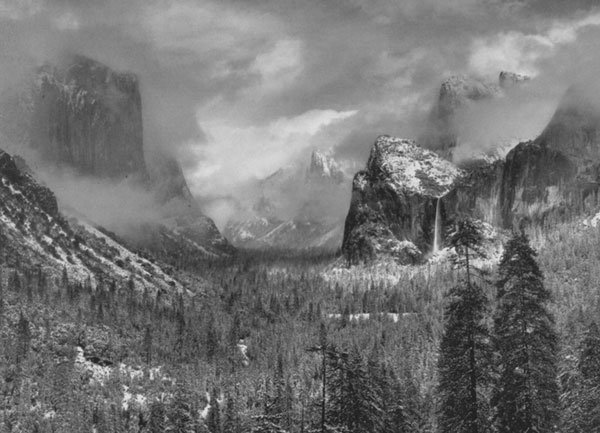Hiking through Point Lobos State Preserve one afternoon last
month, I discovered a picture-perfect panorama waiting around
the bend of the trail. I peeped through the viewfinder of my
Olympus digital camera as storm-generated waves smashed into the
rocky shoreline.
Hiking through Point Lobos State Preserve one afternoon last month, I discovered a picture-perfect panorama waiting around the bend of the trail. I peeped through the viewfinder of my Olympus digital camera as storm-generated waves smashed into the rocky shoreline. Massive fountains of sea spray launched into the winter sky. I snapped the shutter.
Maybe Ansel Adams, one of the world’s most famous photographers, had also stood at this spot with his own camera and captured images of similar wave impacts. He’d often strolled these trails. In his final years, he’d made his home on the Carmel Highlands in sight of Point Lobos.
Adams is an inspiration for all of us amateur camera buffs. He also is one of the greatest artists America has ever produced.
Born on Feb. 20, 1902, in San Francisco, Adams grew up among the sand dunes beyond the Golden Gate before the magnificent bridge was built. Imagine the toddler looking upon that great gap opening into the bay. Here’s where he got his first taste of Mother Nature’s majesty. He must have felt awed. Maybe the scenery’s emotional drama sank deep into his soul – to appear in the great photographs he later created.
The boy’s parents were liberal-minded people. Charles Adams, his father, was particularly keen on the writings of Ralph Waldo Emerson and shared with his son the ideas of the Transcendentalists. The notion that individuals can have a direct connection with God – especially in the wild country – also played an important part in Ansel Adam’s evolution as an artist.
In 1915, Adam’s father gave his son a year-long pass to the Panama Pacific Exposition. Instead of attending school, the 13-year-old boy daily wandered the grounds of this famous fair on the bay’s Treasure Island. Here his fertile imagination absorbed the wonders of the world, including an appreciation for art and architect. No doubt he strolled through the finely crafted pavilion house Japan graciously presented to the fair – a dwelling that would later be moved to a Gilroy garlic farm (and still stands there as a historic home).
In the summer of 1916, the teenage boy took his first trip to Yosemite. He’d pleaded with his parents to take him to the Sierras, and they’d made the journey across the San Joaquin Valley and up into the awe-inspiring mountain valley.
Adams brought a Kodak Brownie box camera his parents had given him as a gift. With it, he captured roll after roll of images – simple snapshots such as millions of Yosemite tourists have taken.
But the boy was no ordinary tourist. That camping trip planted a seed. He dreamed of drawing on film the essence of wilderness spirit. Together, he and nature would create great art.
Over the next decade, he developed his photography skills. He and friends – and a girlfriend named Virginia Best whom he’d later married – spent days roaming the trails of the Sierras. On one memorable hike in 1927, he made one of his most famous photographs. The image “Monolith, the Face of Half Doom” captures the craggy granite mass with a clear and sharp focus. His use of a red filter on the camera lens blackened the sky for a highly dramatic effect.
A short time after making this photograph, he met Albert Bender, a patron of the arts in San Francisco who saw the genius in the young man. Bender underwrote a portfolio of 18 Adams prints. A hundred copies were published at $50 a piece.
Somehow, a copy got into the hands of Alfred Stieglitz, curator of New York art gallery An American Place. The influential Stieglitz was a man who made artists famous. Greatly impressed by Adam’s portfolio, he proclaimed: “These are some of the finest photographs I have ever seen.”
In November 1936, Adams opened his one-man exhibition at An American Place. It was a massive success and made Adams well-known in the art world.
The next year, the board of directors of the Sierra Club called upon him to lobby Washington politicians in preserving Kings Canyon from lumber companies. Adams showed the congressional representatives his photographs of the rugged canyon running through the Sierras. These images paved the way to Kings Canyon’s creation as a national park in 1940.
In 1980, Ronald Reagan presented Adams with the Presidential Medal of Freedom. The honor was “for his efforts to preserve this country’s wild and scenic areas, both on film and on earth.”
Adams died on April 22, 1984, from heart disease in a Carmel hospital. Shortly afterwards, a Sierra peak near Mt. Whitney was named in his honor. And Congress approved the creation of the Ansel Adams Wilderness to protect a portion of his beloved mountains.
Some people question whether photography really is an art form. Their argument is that a photographer simply points a lens at an object and presses a button. The process is more record-taking than art. And for most people holding a camera, that’s pretty much true.
But if you’ve seen an Ansel Adams print, you’ve seen something much more than a mere document. Adams wasn’t into just “taking” pictures. He knew the magic of “making” pictures. And there’s a world of difference in that paradigm shift.
Pinned to the door of the photo lab at the Gilroy Dispatch office is a poster of a photograph taken in front of the mission church in San Juan Bautista. It shows a grinning Ansel Adams surrounded by a bunch of school children on a field trip. The posed picture says a lot about the man. Beyond the art and the honors, he cared about people. He wanted to share with everyone, through his photographic art, the wonders of the wild.
I thought about that poster while wandering the trails of Point Lobos with my Olympus last month. A storm wave crashed the rocks. Framing it with the dead branches of an old Monterey cyprus tree, I captured the powerful explosion of sea spray. I wondered what Adams might think of my picture.













